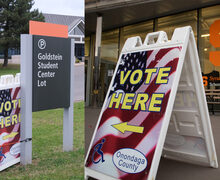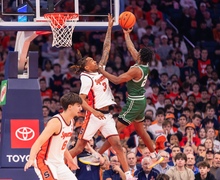A conversation with Jim Boeheim changed my mind about paying college athletes
Daily Orange File Photo
Jim Boeheim said he doesn't think paying college athletes is possible.
Earlier this month, I sat down with Syracuse men’s basketball head coach Jim Boeheim in his office at the Carmelo K. Anthony Center to discuss whether college athletes deserve compensation.
Before I talked with Boeheim, I whole-heartedly supported the bill proposed by New York State Senator Kevin Parker that would require college athletic departments to give 15% of their annual revenue to student-athletes and allow them to sell the rights to their own names, images and other media.
But it’s not so simple.
It was late in the afternoon and I’d spent the previous half hour traversing campus in the pouring rain, sheltering the notes and questions I’d scribbled down that morning under my sweater. I had some very specific thoughts I wanted to discuss with Boeheim based upon what little I knew on the subject.
I was fortunate, then, that Boeheim seemed to foretell my lack of understanding. He jumped right into the nuances and intricacies of paying college athletes that I never would have considered.
Boeheim began by reflecting on a conversation he had with NBA legend and current “Inside the NBA” analyst Charles Barkley.
“I was with Charles Barkley the other night and he made a great point,” Boeheim said. “If you’re at Alabama, then you’ll get money. You’ll do a commercial or something. So who’s going to get the commercial? The quarterback, the point guard, running back. Maybe they get a $50,000 commercial, just throwing that out there. What’s the tackle say? What’s the guard say?”
I answered. “Where’s my money?”
“Where’s my money?” Boeheim repeated. “I think they’re gonna do that. It has unintended consequences.”
There’s no way you can pay players. I don’t think there’s any way you could possibly pay players.-Jim Boeheim
The dilemma lies in equity: Who’s to say what each individual athlete deserves compared to their peers from an entirely different sport or school? If I’m a member of the fencing team who puts just as much time and hard work into my workout regimen as a basketball player does, shouldn’t I also be cut a salary for my labor?
People often trivialize sports, but for many athletes, their endeavors mean more than throwing a ball into a hoop or poking someone else with a stick. The war of an athlete is an internal one waged against history, against injustice, against failure, against circumstance and against dearth of opportunity.
It’s not a question of whether or not college athletes deserve to be paid. They do. The feasibility of making that happen is where it gets tricky.
I later asked Boeheim who profits from the athletic department’s revenue.
“We break even,” Boeheim said. “We — you have to understand, our budget is a couple million dollars, and women’s basketball is a couple million dollars, the same. We have 13 scholarships we have to pay for. They have 15. So all of that money, where does it come from? They don’t make any money, so that comes from us.”
Boeheim said that the most bankable sports fund all of SU’s other programs.
“If you just had basketball and football as your only two sports, you could say, oh yeah, there’s extra money here, we’re making money, let’s give it back,” Boeheim said. “It’s not like that. But that’s what everybody says. They say you’re making all this money, but it isn’t. There is no profit.”
Even with a lucrative athletic program, SU has to rely on the revenue from its top two sports to keep other programs afloat. If schools started paying college athletes directly, the discrepancies between what schools can afford for their athletic departments from campus to campus would widen.
Not only that, but schools with the most merchandisable athletes would be given an advantage in recruiting, which Boeheim pointed out.
“In recruiting there’s always some things going on, you know, behind the scenes,” Boeheim said. “People do this or that. It’s been proven. We don’t. But it’s very tempting if I’m in there with a great kid to say ‘well my friend has this business and he’ll give you this commercial for $50,000.’ That can happen, happens.”
Boeheim emphasized that most people just aren’t aware of how much student athletes are actually getting.
There’s 4,000 players in college basketball on scholarship. 3,900 of them are happy as sh*t cause they’re not going to be pros. They’re getting a free scholarship, right?-Jim Boeheim
“But what people don’t know — let me ask you,” Boeheim said. “How much does a basketball player get at Syracuse right now? What’s he get?”
I said $74,000, the rough cost of attendance at Syracuse that a scholarship would cover.
“In the neighborhood — that’s what you think, and that’s what everybody thinks,” Boeheim said. “But it’s not. Every one of our players — because we can feed them breakfast, they can go over to the snack area there and get a salad and wrap during the day, then we feed them after practice — every one of our players takes his board in cash and his cost of attendance. How much you think that is?”
I took a second to think. “Probably another…”
He finished the thought. “$1,400 a month.”
Boeheim said he didn’t realize players got that much until his son who plays for the team received the check.
“You get a check for $1,400 each month and you have to buy your food out of that. But we give you two or three meals a day. So, now, if you’re a needs student who I worry about more, you get a Pell Grant for $5,000. So now if you’re a needs student, you get $2,000 a month, plus your tuition.”
“Is there a specific place that’s supposed to go, the $2,000?” I asked.
“In your pocket,” he replied.
That surprised me. “Just for whatever you want?”
“For whatever you want,” Boeheim said. “We have to train our players. Too many times they go out and buy the video games, the sneakers, you know. My point, my only point is, student athletes are getting a lot more now. It used to be when I was in school, you got a scholarship and you ate in the dorms, and if you were late, you didn’t get to eat in the dorms. So if you didn’t, you had to pay your own food. So now we feed them and they get money. So it’s a lot better now, and we’re trying to improve that as much as we can. That’s what we’re pushing for.”
Syracuse, and other schools of comparable budgets and sizes, may be able to afford these unique grants and programs, but we have to think about what each school individually can manage. It would be impossible to have a set standard for what every school in every state has to give their players. That would get out of control. It has to be on the shoulders of each individual university to treat their student-athletes not only as elite athletes, but also as people with stories and struggles.
Those improvements need to happen on a case-by-case basis. Whether it be on the court, field, ice or in the water, these performers are more than athletes. They toil, they grow, they learn discipline. There are matters of the soul that sports provide which are intrinsically valuable and that money will never be able to furnish.
I was an athlete growing up — if that term isn’t exclusive to people who are actually athletic — and I can account for the life lessons that sports provide. But it’s also laboriously hard work, both mentally and physically. It should be treated like it.
Student athletes deserve a share of the massive amounts of revenue they produce, whether it be directly through ticket sales, through donor support or through the use of their names, images and other media.
Despite spending, the numbers show that there is money for us to put in player’s pockets. Boeheim brought up his own paycheck as an example of a place SU spends a considerable amount of money. Boeheim said he’s happy to be paid, but he did acknowledge that the system works heavily in his favor.
“The one bad thing is coaches make a lot of money,” Boeheim said. “When I started I made $25,000. But things changed. The way the system works — capitalism — if you do well, you get paid.”
Money and power always tip in one direction. But we can make strides in college sports to tip them in the right direction: toward the human beings whose blood, sweat and tears are offered up on that stage so that the rest of us might believe in the conquer-ability of our circumstances and the creation that is found in our failures.
Sam Bova is a freshman writing and rhetoric major. His column appears bi-weekly. He can be reached at sabova@syr.edu. He can be followed on Twitter @sam_bova.
Published on October 9, 2019 at 12:49 am





